Sep 29, 2020 | Feature |
by Madison Archer Contributing Writer
On September 11th through the 13th and the 18th through the 21st, the Farmington Fair hosted King and Queen Fries and Mr. and Mrs. Sausage from 11 a.m. – 7 p.m. Masks and social distancing were also required.
Rupert Pratt, the Chairman Board of Directors for the Franklin County Agricultural Society (FCAS), said, “Mr. and Mrs. Sausage is going to be doing doughboys,” a sweet concoction of deep fried dough topped with powdered sugar
Neal Yeaton, the Secretary of FCAS, said that “people have been cooped up, I think next year there will be a lot more interest in the fair and in the racing and everything going on.”
The fair attracts a lot of people for the racing alone so not being able to have that income is going to affect the horse owners and caretakers.
4-H is a club for kids to learn by doing real-life and hands-on activities dealing with agriculture. Yeaton hopes to “keep the 4-H kids involved enough so they’ll come back with the exhibition hall and with their animals” since showing animals is a big part of the Farmington Fair as well.
Glenda Barker, a Director in FCAS said “This is Farmington Fair weather,” as she walked into the exhibition hall for the FCAS meeting.
“The RSU-9 schools would usually get out early on Wednesday of the fair week, a beloved tradition to look forward to. This year there is no fair and Wednesday is the school’s day to clean,” Yeaton said.
Dana Levasseur, owner of Mr. and Mrs. Sausage is usually really busy during the week of the Farmington Fair.
This year though, the closure of fairs statewide has made a “huge economic impact for everybody, food vendors, propane vendors, it’s a huge trickle down effect,” said Lavassuer.
Levasseur was excited to announce that they had added fried oreos and fried dough to their menu for the weekend of the 18th.
Being able to show the town that the fair organizers are still being active and still have events is important to Barker. Even with COVID-19 guidelines, FCAS wants to be able to help the community feel connected and this is one way they can help. Since the future is uncertain the group just remains hopeful that the 2021 fair will not be cancelled like fairs in the Midwest have started doing.
While discussing the vendor’s success, Barker said “I think it was good that we could organize this, because it just shows the town that we did something.” Giving the locals something that they can hopefully enjoy was major to the FCAS.
Hopefully the recent good weather will lift up the spirits of those disappointed by the lack of rides and events at the fair this year.
Although this year will not be as exciting for the locals, 4-H students or vendors, there may be some semblance of normalcy thanks to food vendors like MR and MRS. Sausage and King and Queen fries.
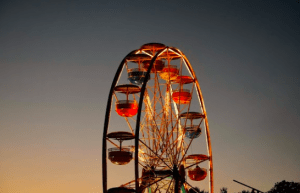
Sep 26, 2019 | News |
Riley Bartell, Contributing Writer
The Farmington Fair always draws a large crowd of college students and Farmington locals. The town of Farmington seems to come alive when the fair is in town. The 179th Annual Farmington Fair is no exception. It opened on Sunday, Sept. 15 and runs through Saturday, Sept. 21.
The fair offers a variety of shows and exhibitions, including Drag Your Neighbor and a demolition derby. A walk down the midway is filled with rides for a range of ages, games made to test your skills in hopes of winning a prize, and many types of food, including sausages, fried dough, and cotton candy.

The Farmington Fair annually brings together the community for festivities and events (Photo courtesy of the Farmington Fair website).
“I love the horse races and fried food,” said Gavin Arsenault, a senior at UMF. “One of my close friends also competes in Drag Your Neighbor. He didn’t win but it was still fun to watch. The fair always draws me in.”
Drag Your Neighbor is a popular event for the local people. Cars of all kinds gather on the dirt track to race each other. This event was temporarily postponed due to a local emergency, but still gathered a sizable crowd.
WWE Wrestling enthusiasts were treated to a show put on by the North Atlantic Wrestling Association. A temporary ring was set up in one of the pulling rings and a crowd gathered to cheer and heckle the wrestlers. Former WWE wrestler Tony Atlas attended the event and signed autographs for all of his fans.
Other events include harness racing for those who would like to try their luck, exhibition halls filled with home grown produce and homemade crafts and the barns that are filled with a variety of livestock, including cows, pigs, goats, horses, sheep, and poultry for the public to view.
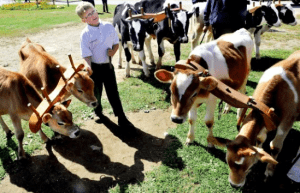
Animals are a popular attraction at the Farmington Fair (Photo courtesy of the Farmington Fair website).
Not all visitors come to the fair for the food and entertainment. Merrily Stevenson and Donna Holbrook come for the cows, animal life and to interact with the public. It provides them with a venue for getting their cows seen by more people, “I have kids here in 4-H, and they show them,” said Stevenson. For cow owners like Stevenson and Holbrook, the fair can be a good place to do business and connect with other farmers. “It’s a great advertising tool,” said Holbrook. “People will come by and see if you have any calves for sale. They’re looking for certain kinds, whether it’s dairy or beef. We sometimes just swap cows, we buy each other’s. We all work together.”
The Farmington Fair was closed on Monday following an explosion in the area which killed one firefighter and wounded several other people. On Wednesday night, vendors and visitors donated several hundred dollars in support of the Farmington firefighters and their families.
The Farmington Fair has special meaning for Ryan Pratt, a senior at UMF. The demolition derby, wrestling and rides all bring back childhood memories. Pratt, a wrestling fan, said, “The wrestling night is funny entertainment and a good promotion for New England wrestling. When I was younger, I always looked forward to going on the rides,” said Pratt. “My grandparents lived right next to the fair so I had easy access. The fair has a great family atmosphere.”
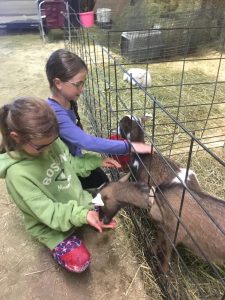
Oct 13, 2017 | Feature |
By Gwen Baker – Contributing Writer
For many people at the Farmington Fair, the animals are an instant attraction. Fairgoers get to see a wide range of unique animals such as goats, cows and ducks.

Scout and Summit with their mother
(Scout: 8 years, top in purple and Summit: 7 years, bottom in green)
“What’s your name?”
“S-C-O-U-T,” replies Scout.
“And what’s your name sweetheart?”
“Summit.”
“How old are you two?”
“I’m eight,” says Scout
“Seven,” says Summit.
“Why are you drawn to the goats?”
“Cuz they’re cute and fluffy,” says Scout.
“And they’re lickable,” laughs Summit.
“Not likeable, but lickable?” asks their Mother.
“And they’re all different,” Scout adds.
“Do you guys go to the Farmington Fair every year?”
“We don’t come every year, as much as we can,” said their mother. “We live in Livermore.” The mother and the two girls moved down the enclosure to another group of goats.
“These guys like you better,” she said. The goats move towards the girls, sticking their heads through the wire. Both the girls kneel down and began patting the goats through the fence.
“Easy Summit they bite,” her mother advised.
“I know,” she replied.

Becca Beatty
(UMF student Becca Beatty poses with cow)
“Why do you like cows?”
“I first realized how awesome cows were on a family vacation to a farm in NH. I watched a baby cow get born and I also got to milk a cow. I asked my mom if we could get a cow and she said no! Every year during fair season, I try to convince her to let me buy a cow. If I were to buy a cow I would want it to be like a pet dog, it would live inside with me, but I don’t think I would fit inside my apartment. They’re like big dogs and I like dogs… and they lick my face.” She pointed to a baby cow. “I wouldn’t have space for a full grown cow, but possibly a baby. I could fit that size into my apartment. My mom however would not be impressed.” The cow started to lick her face. Laughing hysterically, she told it to stay still so it could pose for the camera. “It’s licking my face… It feels like a cat’s tongue only pricklier,” giggled Beatty.
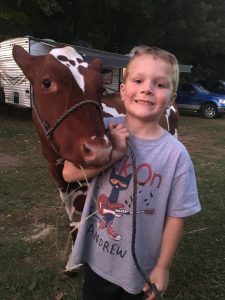
Andrew with Mother Lilly Bagley
(Andrew, age 8 years with Georgia)
“How long have you had the cows and what are their names and breed?”
“We’ve grown up with dairy cattle. It’s kinda our passion,” explained Lilly Bagley. “So we have three Milking Shorthorn and one Ayrshire. And we’ve had them for about two years now,” said Bagley. Pointing towards the fence where the four cows were, she began describing the cows.
“I have Rhonda to the left, and Georgia on the right of the pen. And then I have Gargamel, like from the Smurf Gargamel; she’s the brown one and Frozen, (far right) she’s considered a roan, the coloration of her is considered roan.”
4-H is a program that children from 5-18 can participate in and be involved in different projects, from agriculture to arts and crafts to robotics. Most clubs meet once a month and discuss business and come up with plans that members can do in their project.
“My oldest son [Jason] is able to be in 4-H now so he’s able to work with his own animals,” said Bagley. “My husband and I grew up with dairy cattle, went to college and kinda got out of it, then went back into it when the kids were old enough. He’s [Andrew] almost old enough.”
“To participate in 4h, they have to be nine. And then they do little classes for kids five to eight,” said Bagley.
“My favorite thing about raising dairy cattle is the bond that you form between each animal and that each heifer has its own personality.”
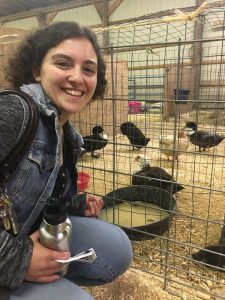
UMF student Elina Shapiro
(Elina Shapiro with Muscovy duck)
“Tell me a little bit about why you like birds?”
“I really have liked birds ever since I took Ornithology my freshman year in college. I took it actually in North Carolina, where I grew up, and ever since I took the class I fell in love with birds,” Shapiro reminisced.
“I’m an avid bird watcher and I love their diversity. I love seeing all the different kinds of birds while I’m out there and though I’d much prefer being out in the field and seeing birds, a lot of the birds that are in here, I have seen in the field.”
She pointed to the duck next to her. “One of which, one of the birds in here called the Muscovy duck was actually very prevalent right near my house and at the campus, I was at where I took Ornithology. It looks kind of funny, so every time I see it, it brings humor I guess you could say. It looks kinda like a combination of a chicken and turkey with warts. I mean it just looks very strange,” Shapiro laughed.
“I love bird watching. I also did a lot of bluebird research for two summers. So bluebirds are my favorite. I wouldn’t call that one my favorite [Muscovy duck], but it brings humor because it looks so funny,” said Shapiro.
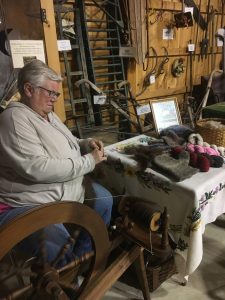
Diane Bolduc spins alpaca yarn on the machine.
“How long have you been spinning?”
“[I’ve been spinning for] twenty-seven years, I’ve been coming [to the Farmington Fair] for thirteen,” said Bolduc.
“What is the process of spinning, how does the machine work?”
“The process is shearing from a sheep or an alpaca, washing and carting it, combing it, then spinning it. I decide how thick or thin I want my yarn to be by thinning it out here. I pull it and thin it out and the spinning wheel twists it. All the spinning wheel does it twist it, and when I’m ready, I let it go. It runs through, it goes through the hole, comes out the others side and runs across these little hooks and winds up at the bobbin,” Bolduc replied, her hands swiftly gesticulating the movements as she demonstrates the process.
“And then when I’m all done I will apply it back on itself, which is twisting the two together, and it will be yarn ready to knit or crochet with,” said Bolduc.
“Does it take practice to get the handle of it?”
“Absolutely, it takes practice. When I first started, I was making rope. It was huge, it was thick, it was overspun. But it’s like anything, the more you do it, the better you get. The more practice. It’s a very touch feel, hands on type of activity. And once you learn how to do it, it’s like riding your bike; you have it forever.” She continued to spin, focusing on the process.
She later mentioned how children on class field trips call the sheep that are colored “Easter sheep.” as well as her amusement when men specifically ask her if they “really have sheep that color.”






